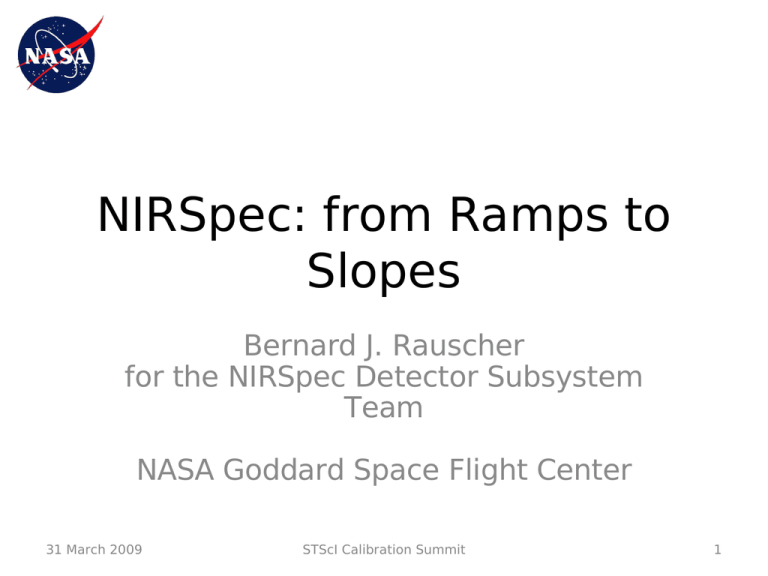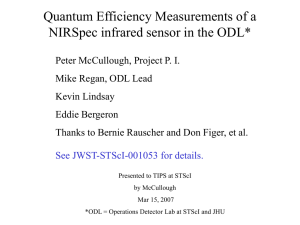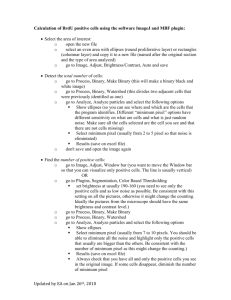NIRSpec: from Ramps to Slopes Bernard J. Rauscher for the NIRSpec Detector Subsystem
advertisement

NIRSpec: from Ramps to Slopes Bernard J. Rauscher for the NIRSpec Detector Subsystem Team NASA Goddard Space Flight Center 31 March 2009 STScI Calibration Summit 1 Topics • Data Format • Pipeline processing • Detector artifacts and pipeline processes needed to correct them • IDL procedures 31 March 2009 STScI Calibration Summit 2 Data Format • NIRSpec used JWST MULTIACCUM (AKA “MULTI-nxm”) sampling – n up-the-ramp groups – m frames averaged per group – Baseline science integration is MULTI-22x4 • Total noise averages down approximately as, • • Where f is total photonic current including dark current Eqn. 1 neglects 1/f noise, which NIRSpec testing has shown to be significant with the SIDECAR ASIC. It therefore slightly underestimates the noise of JWST flight systems. 31 March 2009 STScI Calibration Summit 3 Set of Dark Ramps Example: GSFC Pipeline Processing Pixel-toPixel Crosstalk MKMULTI REFSUB NOTE: REFSUB is frequently called by MKMULTI to do both boxes in one step Slope Images Mean Image ITERCOMBIN E Sigma Image HOT_PIXEL_ CROSSTALK IMHI2 Dark Rate Other 31 March 2009 Analysis STScI Calibration Summit IMHI 2 Total Noise 4 Dark Ramps Other Data Products Derived from Dark Ramps POWSPEC_S CA, DINO FFT Noise Analysis SNOW BALL Snowball Analysis FIND_COSMIC_RA YS, CR_CROSSTALK BIAS_DRIFT 31 March 2009 Pixel-toPixel Crosstalk Bias Drift Outputs Correlations STScI Calibration Summit CDS Noise 5 Slope Fitting Using MKMULTI (This IDL Procedure is included in the deliverable FPQLA Software) • MKMULTI computes integrated signal per pixel, • Pixel slopes computed using standard 2parameter least-squares fitting. For each pixel, • The standard equations (see e.g. “Numerical Recipes in C the Art of Scientific Programming”) are, 31 March 2009 STScI Calibration Summit 6 Reference Pixel Correction using REFSUB (1) • (This IDL Procedure is included in the deliverable FPQLA NIRSpec’s HAWAII-2RG Software) SCAs include 2 types of reference pixel 0.0 e-/s/pixel +0.010 Reference pixels in rows • Available on all outputs • These are always used! 31 March 2009 0.0 e-/s/pixel +0.010 Reference pixels in columns • Available on outputs #0 and #3 only (2 of the 4 outputs) • These are sometimes used • Should be treated with caution because their use involves making assumptions about noise correlations across outputs STScI Calibration Summit 7 Reference Pixel Correction using REFSUB (2): Using Reference Pixels in Rows • In the IDL zero-offset array indexing convention, these are pixels, [*,0:3] & [*,2044:2047]. • • Each output is treated independently For each output, the horizontal reference pixels are used in one of two ways. “Reference Rows Only” “Simple” •For each output, we compute the mean •For each output, we compute [or median] of the reference pixels in the mean [or median] of the rows; (“bottom”) 0:3 & (“top”) 2044:2047 reference pixels in rows - If computing means, we use 2044:2047 DJS_ITERSTAT to implement - If computing means, we iterative sigma clipping - If computing medians, we use use DJS_ITERSTAT to the IDL median function implement iterative sigma -For each output and using the “top” and clipping “bottom” reference pixel values, - If computing medians, we interpolate a reference pixel value for each row use the IDL median •The model value for each row is function subtracted from every pixel in the row. •31The mean (or median) value is March 2009 STScI Calibration Summit 8 subtracted from every pixel in Reference Pixel Correction using REFSUB (2): Using Reference Pixels in Columns • Because only 2 of the 4 outputs actually have reference columns, the reference columns should be used only if there is significant (>~50%) output-to-output noise correlation – – For NIRSpec, it is not clear yet whether this condition will be satisfied For our “Pathfinder Detector Subsystem”, this condition was not clearly satisfied “Teledyne Imaging Sensors (TIS) Baseline” “GSFC Approach” •Testing shows this to be slightly (1%2%) more powerful than the TIS •Needs to be done after applying approach a reference pixel correction using •Each half of SCA treated reference pixels in rows. independently •For each row, subtract a rolling •All 4 reference columns on one half average of 4 reference rows on averaged together to form a mean either side of the current row. reference column for that half •Optionally, the two halves of the •Mean reference column is smoothed SCA can be treated using either a Savitzky-Golay filter or Gaussian smoothing kernel. independently. •Smoothed mean reference value subtracted from every pixel in the 31 March 2009 STScI Calibration Summitrow 9 current IDL Procedures • The NIRSpec Detector Subsystem Team at GSFC works mostly in IDL • We have delivered a Focal Plane Quick Look Analysis (FPQLA) package to ESA • The FPQLA implements much of what we have discussed; slope fitting, reference pixel correction, etc. • We are willing to share this software on a best-effort basis with others in JWST • The FPQLA software runs on Red Hat Linux 31 March 2009 STScI Calibration Summit 10





